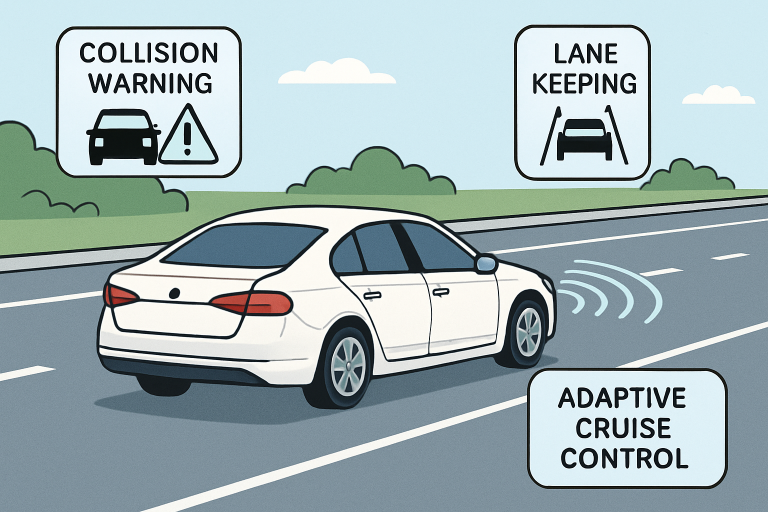
With the integration of artificial intelligence, sensor networks, and real-time monitoring, car manufacturers are setting new benchmarks for safety and convenience. These intelligent safety systems are helping to lower accident rates and paving the way for future vehicles that respond proactively to potential hazards, often quicker than a human can.
Automotive safety has entered an exciting new era as innovative technologies transform how we drive. From preventing collisions to keeping drivers alert, these advancements are making our roads safer than ever before. Modern vehicles now come equipped with smart systems that not only assist but also actively protect drivers, passengers, and even pedestrians. For those interested in seeing these features firsthand or considering an upgrade, learn more about the latest models and their advanced safety packages.
Automatic Emergency Braking (AEB)
Automatic Emergency Braking, or AEB, is fast becoming a must-have for every new vehicle. Using onboard radar, cameras, and sensors, AEB systems detect obstacles or sudden traffic stoppages and automatically apply the brakes if the driver fails to react in time. This rapid-response capability can prevent crashes entirely or minimize their severity. In fact, the Insurance Institute for Highway Safety found that vehicles equipped with AEB see rear-end collision rates drop by up to 50%.
Driver Monitoring Systems (DMS)
Distraction and drowsiness are major causes of accidents, but Driver Monitoring Systems (DMS) are a powerful countermeasure. These systems use specialized cameras and sensors to monitor driver alertness in real time. If the system detects signs of sleepiness or inattentiveness—like closed eyes, yawning, or erratic steering—it emits alerts or, in more advanced cases, can gently guide the vehicle to safety. This direct intervention is a leap forward in addressing human error, which remains the root cause of most road incidents.
Adaptive Cruise Control (ACC)
Adaptive Cruise Control (ACC) uses radar and camera integration to manage speed and maintain a preset distance from the car ahead. This reduces driver fatigue and enhances safety on long highway journeys, making daily commutes less stressful.

Lane Keeping Assist (LKA)
Unintentional lane departures are common and can lead to dangerous sideswipe accidents. Lane-keeping assist technology helps by recognizing road markings and issuing gentle steering corrections to keep the vehicle centered within the lane. By reducing the risk of drifting out of bounds, LKA proves especially valuable on highways and during extended road trips. According to the National Highway Traffic Safety Administration, vehicles equipped with LKA substantially cut down on serious side-collision incidents.
Blind Spot Detection
Blind spot detection systems, which continuously scan adjacent lanes, alert drivers when a vehicle enters the “blind zone,” enhancing awareness and encouraging safer lane changes. According to the Insurance Institute for Highway Safety, blind spot detection reduces lane-change crashes by 14% and injury crashes by 23%.
Vehicle-to-Everything (V2X) Communication
One of the most innovative recent developments is Vehicle-to-Everything (V2X) communication. V2X allows vehicles to exchange information with each other and surrounding infrastructure, such as traffic lights, road signs, and even pedestrian smartphones. This data-sharing ecosystem provides early warnings about hazardous road conditions, upcoming traffic slowdowns, or potential collisions at intersections. As cities and vehicles adopt this technology, we can anticipate fewer accidents and smoother traffic flows as vehicles “talk” to one another to ensure public safety.
Augmented Reality (AR) Dashboards
Augmented Reality dashboards bring the future directly to your windshield. Instead of glancing down at instruments or infotainment screens, vital information such as speed, navigation prompts, speed limits, and collision warnings is projected directly into the driver’s line of sight. This helps keep eyes on the road and enables faster response times in sudden situations. As AR becomes standard in premium and, increasingly, mainstream vehicles, drivers are experiencing a seamless and less distracting interface with their driving environment.
The Road Ahead: What Drivers Can Expect
Advancements in car safety technology, including proactive systems, real-time driver support, and networked communication, are making entry-level vehicles safer than top-tier models. Manufacturers and researchers continue to refine innovations, promising a safer future for all road users. Reviewing options and testing advanced vehicles can help drivers find the ideal fit.
FAQs
Q: What is Automatic Emergency Braking (AEB), and how effective is it?
A: AEB uses radar, cameras, and sensors to detect obstacles and automatically applies brakes if the driver doesn’t react in time. It reduces rear-end collision rates by up to 50% according to the Insurance Institute for Highway Safety.
Q: How do Driver Monitoring Systems help prevent accidents?
A: DMS uses cameras and sensors to monitor driver alertness in real time, detecting signs of drowsiness or distraction. When issues are detected, the system emits alerts or can guide the vehicle to safety.
Q: What benefits does Adaptive Cruise Control provide?
A: ACC uses radar and cameras to automatically manage speed and maintain a safe distance from the vehicle ahead. This reduces driver fatigue and enhances safety during long highway journeys.
Q: How much do blind spot detection systems reduce crashes?
A: According to the Insurance Institute for Highway Safety, blind spot detection reduces lane-change crashes by 14%. It also cuts injury crashes by 23% by alerting drivers when vehicles enter their blind zones.
Q: What is Vehicle-to-Everything (V2X) communication?
A: V2X allows vehicles to exchange information with other vehicles and infrastructure like traffic lights and road signs. This data-sharing provides early warnings about hazards and potential collisions for improved safety.



